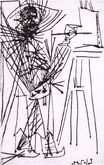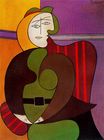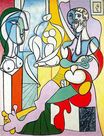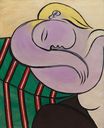©Пабло Пикассо - Сидящая женщина в красном кресле 1931
 |
 |
 |
 |
 |
 |
 |

Сидящая женщина в красном кресле 1931
131x98см масло и риполин на панели
Art Institute of Chicago, Chicago, IL, USA
The image is only being used for informational and educational purposes
<< Previous G a l l e r y Next >>
From Art Institute of Chicago:
Pablo Picasso painted numerous portraits of the many women in his life. Often the circumstances surrounding his relationships or the distinct personalities of his sitters seem to have precipitated stylistic changes in his work. Marie-Thérèse Walter came into the artist’s life around 1925. Though twenty-eight years her senior, Picasso was smitten and began making furtive references to her blond hair, broad features, and voluptuous body in his work. Perhaps acknowledging the double life he and she were leading, he devised a new motif: a face that encompasses both frontal and profile views.
Picasso experimented beyond form and style, exploring different materials— including found objects such as newspaper, wallpaper, and even studio scraps—in his work. The Red Armchair demonstrates the artist’s innovative use of Ripolin, an industrial house paint that he first employed as early as 1912 for its brilliant colors, as well as its ability to provide an almost brushless finish if used straight from the can. In preparation for an exhibition of his work at the Galeries Georges Petit in 1931, Picasso began a series of large paintings of Marie-Thérèse, of which The Red Armchair was the first. Here he mixed Ripolin with oil to produce a wide range of surface effects— from the crisp brushmarks in the yellow background, to the thick but leveled look of the white face and the smooth black outlines of the figure.
— Entry, The Essential Guide, 2013, p.272.